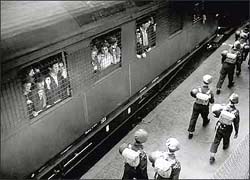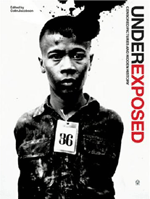December 2002
CarnivorePE
“CarnivorePE (Personal Edition) turns your computer into a personal data surveillance tool. Use CarnivorePE to run Carnivore clients from your own desktop, or use it to make your own clients. Read the FAQ, or view a screenshot of CarnivorePE in action with Mark Napier’s ‘Black and White’ client.”
 CarnivorePE is a packet sniffer designed by the “Radical Software Group” to emulate Carnivore one of the FBI’s email wiretapping systems (at least according to what we know about it.) CarnivorePE allows artists to translate traffic on a computer network into abstract visuals based on customizable filters.
CarnivorePE is a packet sniffer designed by the “Radical Software Group” to emulate Carnivore one of the FBI’s email wiretapping systems (at least according to what we know about it.) CarnivorePE allows artists to translate traffic on a computer network into abstract visuals based on customizable filters.
While CarnivorePE does call attention to Federal wiretapping and, to a degree, how insecure networks can be, I find it utterly complacent. The project actually makes no comment about data insecurity or FBI surveillence. Instead it takes it as a departure point, as a given, makes it pretty, and even wins cash and props (see the praise of the art press and the list of funders at the bottom of the page.) The project does practically nothing to educate users about Internet security or to encourage better security habits. The project does nothing to push for greater disclosure of government surveillence or greater restrictions. In fact, the equation seems to be that more surveillence means more pretty art.
Whether you go for the technical fix or the political one, there are more constructive ways to apply your technical and creative talents. Why not develop entertaining and easy to understand materials to teach about computer and Internet security, privacy, anonymity? Encourage the use of encryption? Take action in the campaign against the FBI’s use of Carnivore? Or join Project Vegan, an anti-Carnivore set of Free Software tools in much need of contributers?
Delirious New York
Twin Towers steel set for US warship:
“Steel salvaged from the wreckage of the World Trade Center in New York has been sent to a Mississippi shipyard to be used in the construction of a new US warship.
According to reports, a massive structural beam which supported the south tower will be used to build USS New York, an amphibious vessel capable of carrying more than 1,000 soldiers.”
The $800-million vessel should be ready for active duty in 2007.
Camp
While browsing the DefenseLINK site looking for some good public domain photos, I found a bunch the Pentagon had recently released of the new U.S. detention center at Guantanamo Bay.
The United States was harshly criticized for the brutal, crude design of Camp X-Ray. Photos were widely circulated of prisoners at squatting in their chain-link cells in the blazing Cuban sun.
Five miles down the road, Camp Delta is now open for business. Photos of a detention block and spotless
cells make it seem like an improvement. (Even the name “Camp Delta” reads like a hokey PR move.) Camp Delta has indoor plumbing, each unit its own flush toilet, metal bed-frame and a sink with running water. None of this was available at Camp X-Ray where buckets and portable toilets were used. No detainees in any of  the new photos, though.
the new photos, though.
The $9.7 million dollar contract for the construction of the camps went to Brown and Root, a subsidiary of Halliburton. The contract could eventually total as much as $300 million if additional options are exercised. Vice President Dick Cheney is the former chief executive officer of Halliburton.
In addition to the new cells, Camp Delta has its own recreation and exercise area, library, outdoor shower, hospital and ward. “Comfort items” distributed to detainees including a prayer mat, cap, flip flops and two-piece suit.
And, dental care is provided at the detainee hospital.
Free dental care? It’s more then most Americans get.
But then another look at that chair and the skin starts to crawl. One suspects the U.S. isn’t terribly concerned with the beautiful smiles of its “enemy combatants.”
Indeed, this morning’s Washington Post describes secret overseas CIA interrogation facilities where detainees are
being tortured. The same torture techniques are of course denounced by the U.S. State Department in its annual survey of human rights violations in other countries. In fact its in some of those very countries where the CIA is setting up shop. Says one U.S. official, “If you don’t violate someone’s human rights some of the time, you probably aren’t doing your job.”
Says Human Rights Watch:
“Direct involvement or complicity in torture, as well as the failure to prevent torture by subordinates, may subject U.S. officials to prosecution under international law. Such acts are ‘grave breaches,’ or war crimes, under the 1949 Geneva Conventions. In addition, the Convention against Torture [which the U.S. has ratified] obligates all countries to prosecute persons within their jurisdiction who are implicated or complicit in acts of torture. Any competent court anywhere in the world is required to prosecute violations of the prohibition against torture.”
According to U.S. officials, nearly 3,000 suspected al Qaeda members and their supporters have been detained worldwide since September 11, 2001.
U.S. Racism in Pictures

“A documentary with 3,000 pictures, music, interviews and narration presented on two screens for audiences of up to 2,000... A lecture on racism, oppression, poverty and social injustice with more than 5,000 presentations in American and European Higher Education.”
...
See also 30 photos from 1937-1943 of signage enforcing racial discrimination. From the Library of Congress:
“Photographers working for the Farm Security Administration Historical Section (later transferred to the Office of War Information) were encouraged to document continuity and change in many aspects of life in America during the years the unit was in operation. They were particularly encouraged to photograph billboards and signs as one indicator of such developments. Although no documentation has been found to indicate that photographers were explicitly encouraged to photograph racial discrimination signs, the collection includes a significant number of this type of image, which is rarely found in other Prints and Photographs Division collections.”
Underexposed
 The people in the black and white photo behind the bars of the boxcar in the 1940’s German train station are not Jews off to the camps to be killed. They are indeed German Jews off to a camp, but the photo was taken after the end of war, the soldiers on the platform are British, and the passengers are survivors of Nazi concentration camps, denied entry into Palestine. Here, they are being transported from Hamburg docks to the Poppendorf detention camp.
The people in the black and white photo behind the bars of the boxcar in the 1940’s German train station are not Jews off to the camps to be killed. They are indeed German Jews off to a camp, but the photo was taken after the end of war, the soldiers on the platform are British, and the passengers are survivors of Nazi concentration camps, denied entry into Palestine. Here, they are being transported from Hamburg docks to the Poppendorf detention camp.
The photo and its story are reproduced in Underexposed. From Vision On Publishing:
“Underexposed tells the stories behind the photographs which determine our view of history, providing a reality check on alleged events from the last hundred years and documenting the struggle of the powerful to contend with rival cultural forces of media and information. Reclaimed from the trash cans of the Second World War. From the cruelty of Stalin’s Russia and fundamentalist chaos in Iran to the horrors of the Gulf war and perspectives on September 11th — even Hitler’s preening speech rehearsals come back to argue with his self-made myth. Via disgruntled starlets, ecological destruction and US nuclear tests, Underexposed gathers together some of the most ideologically dangerous photographs ever taken and releases them to haunt the increasingly manipulated, re-touched present.”
 I found the book on the front table at St. Mark’s Books, mixed with the latest compilations on cyber-typography, club flyers, erotica, and graphic novels. The juxtaposition is continued on the publisher’s Web site. Among the publisher’s list of glossy photo books of rock stars, fashion, erotica, and a celebration of the Manchester City Football Club (and its fans), Underexposed seems a bit like war porn. The design of the book is certainly less than sober, full of dramatic, oversized, full-bleed spreads and a hip sans serif typeface. Each photo is provided with some background, but the captions only allow so much space.
I found the book on the front table at St. Mark’s Books, mixed with the latest compilations on cyber-typography, club flyers, erotica, and graphic novels. The juxtaposition is continued on the publisher’s Web site. Among the publisher’s list of glossy photo books of rock stars, fashion, erotica, and a celebration of the Manchester City Football Club (and its fans), Underexposed seems a bit like war porn. The design of the book is certainly less than sober, full of dramatic, oversized, full-bleed spreads and a hip sans serif typeface. Each photo is provided with some background, but the captions only allow so much space.
The bottom line: photographs can lie. Particularly those that purport to be objective. Taken out of context, they are cropped, altered, and framed by the context at hand and by cultural assumptions. And page after page, the flouting of taboo and power starts to flatten out. Like all the speakers in the corner of Hyde Park, all ideologies become equivalent.
That said, the book does rouse a healthy dose of skepticism. It also crosses into the terrain of Barthes’s Mythologies, an examination of connections between language, imagery, ideology, and power and a wandering interrogation of “the obvious.”
From a review in The Guardian:
“In one of the most shocking images, taken from the Sudanese famine of 1984, Wendy Wallace photographed the photographers at work snapping an emaciated child who had been brought out to sit in the dirt precisely for that image.
It is a theme that recurs in Alex Webb’s pictures of the American invasion of Haiti. A line of US troops lies dramatically - heroically - on the Tarmac at Port au Prince airport aiming their weapons at an unseen enemy. Most media organisations showed this image. Webb’s version shows the reality: the only figures are half a dozen and more photographers and cameramen crouched in front of the soldiers, puncturing the dramatic image in a campaign that was to see virtually no opposition to US troops.”
See an excerpt from the forward to the book, some photos from the book, or listen to an audio interview with Colin Jacobson, former photo editor for a number of British news magazines and editor of Underexposed.
...
Also of note, The Commissar Vanishes: The Falsification of Photographs in Stalin’s Russia, an small online exhibit of doctored photos and propaganda posted by the Newseum. Shown here, Stalin with Nikolai Yezhov, commissar of water transport, before and after he was purged.
Forget About It


Drapetomanic sent me a link to a page on Eszter Hargittai’s Web site that has a couple of screen caps of Web sites before and after September 11, 2001.
The three site designs feature the Manhattan skyline whose twin towers were quickly airbrushed from the pages. What’s striking is that the changes occurred within three months of the attacks, as if the polite thing to do is to immediately pretend the towers did not exist.
...
On the flip side, the official Operation TIPS Web page has vanished. Here’s a cached version. The disappearance is probably related to Section 880 of the Homeland Security Act of 2002 which declares that
“Any and all activities of the Federal Government to implement the proposed component program of the Citizen Corps known as Operation TIPS (Terrorism Information and Prevention System) are hereby prohibited.”
Though that didn’t stop New York State from starting their own.
...
Also gone from the Web is the scary logo and much information from the site of the Defense Department’s Total Information Awareness program. See a couple of screencaps of the site before and after. From news.com:
“If fully implemented, TIA would link databases from sources such as credit card companies, medical insurers, and motor vehicle databases for police convenience in hopes of snaring terrorists.
 First, biographical information about the TIA project leaders, including retired Adm. John Poindexter, disappeared from the Defense Department’s site last month. A mirror that one activist created from Google’s cache shows the deleted information included four resumes listing past work experience but no addresses or contact information.
First, biographical information about the TIA project leaders, including retired Adm. John Poindexter, disappeared from the Defense Department’s site last month. A mirror that one activist created from Google’s cache shows the deleted information included four resumes listing past work experience but no addresses or contact information.
Then, sometime in the last week, the TIA site shrank still more and some links ceased to work. The logo for the TIA project—a Masonic pyramid eyeballing the globe—vanished, a highly unusual step for a government agency. So did the TIA’s Latin ‘scientia est potentia’ slogan, which means ‘knowledge is power.’...
The disappearing documents come as the TIA has become a lighting rod for criticism and as online activists have been turning the tables on Poindexter by reposting his personal information and home telephone number as widely as possible....
The TIA project became public early this year when President Bush chose Poindexter, who was embroiled in the Iran-Contra scandal, to run the Information Awareness Office. But criticism of the project from privacy advocates and newspaper editorial pages has spiked in the last month, and the Web deletions appear to have been in response to the increased public scrutiny.”
Doh
The Yes Men, corporate trouble makers and designers of the WTO parody site, marked the 18th anniversary of the Bhopal disaster with the launch of Dow-Chemical.com, a straight-faced parody site using the design of the original, and a cheeky press release in the voice of the corpoation. Unfortunately, their cleverness got the best of them and the site was brought down in a matter of days. (Mirror sites are now up.)
 While funny at first, in context the parody Web site feels a bit thin. Sure it’s fun to parody the public relations language used to bathe coroporations in the soft glow of environmental and corporate responsibiliy. But also marking the anniversary were thousands of people marching in the streets of Bhopal.
While funny at first, in context the parody Web site feels a bit thin. Sure it’s fun to parody the public relations language used to bathe coroporations in the soft glow of environmental and corporate responsibiliy. But also marking the anniversary were thousands of people marching in the streets of Bhopal.
An estimated 500,000 people were affected when 40 tons of lethal gases leaked from Union Carbide Corporation’s pesticide factory in Bhopal in 1984. Today, the number of deaths stands at 20,000. Virtually nothing has been done to clean up the site, and the water used by people for everyday needs is still contaminated. And via Reuters:
“Former Union Carbide chairman Warren Anderson faces charges of culpable homicide and Indian courts have repeatedly asked New Delhi to seek his extradition from the United States where he now lives in retirement. Anderson, considered a fugitive from Indian law for refusing to face charges in its courts, could be jailed for 10 years and fined if found guilty.”
So what of design and social change? Well, a bit of design forensics determined that it was a failure of design that led to the disaster. On December 2, New Scientist published an article on their investigation of the accident and recently released documents that identify the reasons for the failure and show that the company that built and owned the Bhopal plant cut crucial corners and safety features from its design of the plant.
“Union Carbide was forced to release the documents last month by a court in New York state that was hearing a class action suit filed by Bhopal survivors in 1999. According to New Scientist, Carbide’s 1972 memo specified that the US headquarters would either perform all design work for the plant, or approve designs done elsewhere. The report said that on the basis of fresh evidence, the US Company could be tried for negligence only if the Indian government joined the campaigners in the US lawsuit.”
...
Further info via rtMark press release:
“Burson-Marsteller, the public relations company that helped to ‘spin’ Bhopal, has meanwhile sued college student Paul Hardwin for putting up a fake Burson-Marsteller site, http://www.bursonmarsteller.com/, which recounted how the PR giant helped to downplay the Bhopal disaster. Burson-Marsteller’s suit against Hardwin will be heard next week by the World Intellectual Property Organization.
Hardwin, unable to afford a lawyer, has composed a dryly humorous 57-page rebuttal to the PR giant’s lawsuit. On page 7, for instance, the student notes that Burson-Marsteller’s stated goal is
‘to ensure that the perceptions which surround our clients and influence their stakeholders are consistent with reality.’
Hardwin goes on to assert that his satirical domain is doing precisely that, by publicizing
‘academic and journalistic materials about Burson-Marsteller’s involvement with and relationship to, for example, Philip Morris and the National Smoker’s Alliance, a consumer front group designed to create the appearance of public support for big-tobacco policies; Union Carbide and the deaths of 20,000 people following the 1984 disaster in Bhopal; and political regimes such as that of Romanian dictator Nicolae Ceausescu and more recently Saudi Arabia following the events of September 11; and to properly associate them with the relevant Trademark so that they may be understood accordingly by Internet users.’
In response to the suit’s claim that ‘a substantial degree of goodwill is associated with [the Burson-Marstellar Trademark]’ Hardwin offers much ‘evidence to the contrary’ including ‘a newspaper headline in which the Complainant is characterized as “the Devil.”’
The primary goal of RTMark is to publicize corporate subversion of the democratic process. Just like other corporations, it achieves its aims by any and all means at its disposal. RTMark has previously helped to publicize websites against political parties, political figures, and entities like the World Trade Organization and the World Economic Forum.
Make Love, Not War
From The Telegraph, UK:
Arabic love poem puts US Gulf base on red alert
By Jack Fairweather in Kuwait (Filed: 05/12/2002)
US marines in Kuwait were put on full alert yesterday after an unidentified person wrote a love poem in Arabic on a military vehicle.
The marines, unable to translate the simple phrase which begins many Arabic love songs, called the alert when they thought the message contained a terrorist threat. A translator was summoned and confirmed it was merely a poem, the words reading: “I love you forever. Your beauty is incomparable.”
“We’re not used to such things,” said one American soldier serving at Camp Doha, the American military base in Kuwait where troops are preparing for a possible war against Iraq.
It transpired that the message was not meant for the marines but for a lovesick teenager by the name of Fatima.
Bobbie Biodiesel
With their tax on petrol, the Brits developed an unexpected financial incentive for car owners to convert to environmentally-friendly home-brewed biodiesel. But the police are clamping down to make sure the owners still pay their fair share of public roads. From The Guardian:
“A special police unit nicknamed the ‘frying squad’ has been formed in a market town where hundreds of drivers are believed to be running their diesel cars on cooking oil.
Sniffing out unusually fragrant exhaust fumes, highway patrols have already collared several dozen offenders, who save more than 40p a litre by diverting oil from the kitchen cupboard to under the bonnet.
The Asda supermarket in Llanelli, south Wales, has slapped a ration on cooking oil sales, after astonished internal auditors found that it was selling far more than any other outlet in the country. Customs investigators are also involved in the "sniff patrols", which home in on any car smelling like a mobile fish and chip shop.
‘It’s a serious offence,’ said Bill O’Leary, spokesman for customs and excise, which levies tax on motor oil but not on the version used in saucepans. ‘By law, all cars on public roads must pay a tax on the fuel they use. Evasion carries a maximum seven-year jail term.’”
I guess it’s a matter of priorities. I wonder how much fuel tax would pay for one of them electric cars?
Found via Boing Boing
HIV / AIDS / WWW
“Each December 1, World AIDS Day, the creative community observes A Day With(out) Art, in memory of all those the AIDS pandemic has taken from us, and in recognition of the many artists, actors, writers, dancers and others who continue to create and live with HIV and AIDS.
A Day With(out) Art was created by the group Visual AIDS in New York City.
 For the last several years, Creative Time has organized a Day With(out) Art observance on the worldwide web, encouraging diverse website designers and administrators to darken their site and convey AIDS prevention and education information to their visitors.
For the last several years, Creative Time has organized a Day With(out) Art observance on the worldwide web, encouraging diverse website designers and administrators to darken their site and convey AIDS prevention and education information to their visitors.
In 1999, more than 50 webloggers took part in a project called a Day With(out) Weblogs. In 2000, nearly 700 personal weblogs and journals of all sorts participated. In 2001, the number was over 1,000. The personal web publishing community — weblogs, journals, diaries, personal websites of every kind — has continued to grow and diversify.
Once again, everyone who produces personal content on the web is invited to participate a global observance of World AIDS Day. In recognition of the variety of sites participating — E/N sites, weblogs, journals, newspages and more — and to differentiate it from other, similar endeavors, a Day With(out) Weblogs became Link and Think.”
Despite the corny name, Link and Think is one of the more effective online grassroots marketing campaigns I’ve seen. While a Day With(out) Weblogs was more of a memorial and show of solidarity, Link and Think also takes a more forward looking view.
Of the Web logs I check regularly, MetaFilter posted decent set of links. The facts, stories, and images are chilling, but it’s also nice to see a bit of perspective — for instance, asking why AIDS dominates the public health debate.



